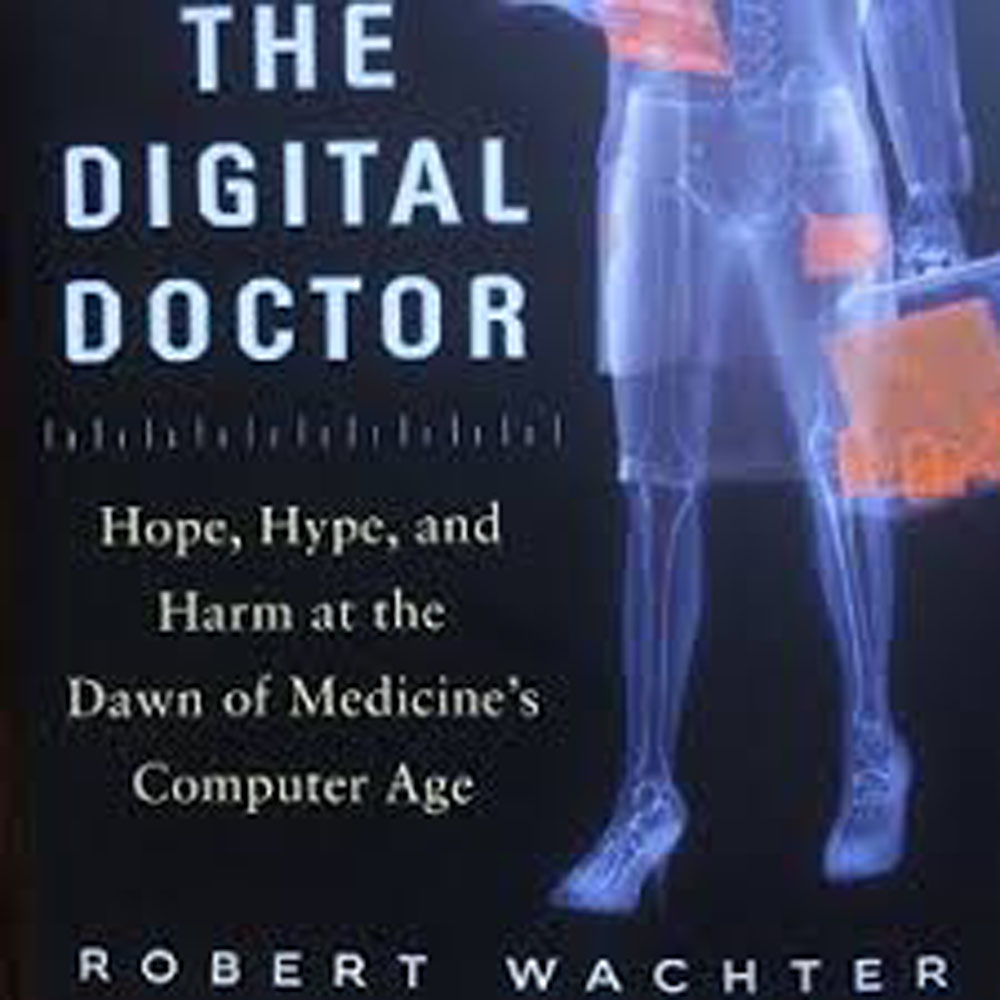Consider Robert Wachter’s vision of the hospital in the not-so-distant future. There will be no more dedicated intensive-care units, because only seriously ill patients will be hospitalized. Rooms will be equipped with wall-size video screens and cameras that allow doctors to expeditiously perform remote examinations. There will be no more nurse call buttons; patients in pain will simply announce their problem and a nurse will appear on a screen. If the physician approves more pain medication, he or she can simply enter it into a computer, which will automatically speed up the patient’s intravenous injection. Medical records will be dynamic documents, always available for patients and families to review on their computers and smartphones.
I am fairly well-versed in the growing use of computerized medicine, yet I was nevertheless stunned to imagine myself participating in such doctor-patient encounters. As I read “The Digital Doctor: Hope, Hype, and Harm at the Dawn of Medicine’s Computer Age,” I found myself feeling nostalgic for medicine before the digital age, even though its challenges sometimes drove me crazy. Is computerized medicine really an improvement on the past? Or are we at risk of losing the vital bond of the doctor-patient relationship?
Fortunately, the author, a practicing internist, has considered these questions carefully. “The Digital Doctor” makes the case that, despite some serious shortcomings, computerized medicine is here to stay and, in the long run, will improve our health.
The authority of the medical profession, Dr. Wachter reminds us, once stemmed from the physician’s presence and touch. Doctors treated entire families, often in their homes, and wrote expansive notes that captured not only the vicissitudes of illness but also the lives of patients. But by the early 20th century, technology was rapidly changing the practice of medicine. The introduction of X-rays, for example, led doctors to divert attention from their patients to images of them. Antibiotics led to miracle cures for diseases like tuberculosis but also meant a growing focus on the disease itself, as opposed to the diseased. Quoting the historian David Rothman, Dr. Wachter argues that doctors were becoming “strangers at the bedside.”
Yet only a Luddite would wish for medicine’s “good old days.” Problems that emerged in the early 1900s, such as incomplete medical records, terrible billing practices and rising costs persisted and even worsened throughout the 20th century. Perhaps the biggest problem has been that of medical errors, which were killing nearly 100,000 Americans each year, according to a 1999 report by the Institute of Medicine.
Physicians and hospitals gradually adopted technologies to try to fix these problems. For example, electronic health records, which were introduced in the 1970s and are now the standard practice, make data much more accessible than written charts by presenting diagnoses, test results and medications at the click of a button. Ideally, they make all of a patient’s past medical history accessible for immediate review.
Meanwhile, computers can store vast amounts of “big data” and be programmed to anticipate mistakes and other adverse events—and to create a series of obstacles to prevent them. Finally, mobile devices and social media can make medicine more efficient. For example, patients are increasingly relying on emailing, texting and Skyping (so-called telemedicine) to communicate with and display their findings to doctors. These encounters should help prevent expensive office visits and hospitalizations.
So, yes, things are better. But “The Digital Doctor” also demonstrates how the use of computers to prevent medical errors has created an enormous set of new problems. Dr. Wachter convincingly shows how electronic health records have transformed physicians into “data entry clerks,” discouraging them from looking directly at patients and disrupting doctor-nurse teamwork—as in the recent case in which a doctor never learned that a possible Ebola patient had recently traveled to Africa. The nurse had entered the information into the computer but hadn’t bothered to tell the doctor directly.
In another astounding story, Dr. Wachter describes how a patient nearly died after being prescribed 381Ž2 tablets of the antibiotic Septra instead of the one pill he was supposed to receive. Neither doctor, nurse nor pharmacist detected the error. In fact, the nurse incorrectly assumed that the electronic health record’s bar-coding system absolutely prevented the improper dosing of medications. Such “blind trust” of computers, the author shows, has itself become a risk factor for errors because it discourages health professionals from speaking up when they are skeptical.
Dr. Wachter well knows that this “brave new world” of medicine makes physicians extremely uncomfortable. The computerization of medicine, he writes, “has been strewn with land mines, large and small.” But the myriad computer gurus that Dr. Wachter interviewed for his book don’t mind. They believe that computers—once rightly adapted to medical practice—will free doctors up to do doctoring as opposed to paperwork, data entry and other trivial tasks. Dr. Wachter, despite his misgivings, agrees.
But I’m not so sure the current generation of doctors—myself included—will ever think that anything can replace being in the room with a patient, touching her hand, sharing a laugh or hearing her baby’s new heartbeat.
Originally published on wsj.com on April 10, 2015
